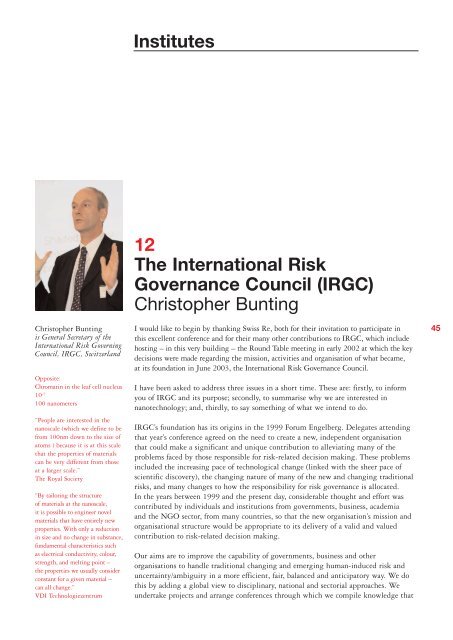Small size - large impact - Nanowerk
Small size - large impact - Nanowerk
Small size - large impact - Nanowerk
Create successful ePaper yourself
Turn your PDF publications into a flip-book with our unique Google optimized e-Paper software.
Institutes<br />
Christopher Bunting<br />
is General Secretary of the<br />
International Risk Governing<br />
Council, IRGC, Switzerland<br />
Opposite:<br />
Chromatin in the leaf cell nucleus<br />
10 -7<br />
100 nanometers<br />
“People are interested in the<br />
nanoscale (which we define to be<br />
from 100nm down to the <strong>size</strong> of<br />
atoms ) because it is at this scale<br />
that the properties of materials<br />
can be very different from those<br />
at a <strong>large</strong>r scale.”<br />
The Royal Society<br />
“By tailoring the structure<br />
of materials at the nanoscale,<br />
it is possible to engineer novel<br />
materials that have entirely new<br />
properties. With only a reduction<br />
in <strong>size</strong> and no change in substance,<br />
fundamental characteristics such<br />
as electrical conductivity, colour,<br />
strength, and melting point –<br />
the properties we usually consider<br />
constant for a given material –<br />
can all change.”<br />
VDI Technologiezentrum<br />
12<br />
The International Risk<br />
Governance Council (IRGC)<br />
Christopher Bunting<br />
I would like to begin by thanking Swiss Re, both for their invitation to participate in<br />
this excellent conference and for their many other contributions to IRGC, which include<br />
hosting – in this very building – the Round Table meeting in early 2002 at which the key<br />
decisions were made regarding the mission, activities and organisation of what became,<br />
at its foundation in June 2003, the International Risk Governance Council.<br />
I have been asked to address three issues in a short time. These are: firstly, to inform<br />
you of IRGC and its purpose; secondly, to summarise why we are interested in<br />
nanotechnology; and, thirdly, to say something of what we intend to do.<br />
IRGC’s foundation has its origins in the 1999 Forum Engelberg. Delegates attending<br />
that year’s conference agreed on the need to create a new, independent organisation<br />
that could make a significant and unique contribution to alleviating many of the<br />
problems faced by those responsible for risk-related decision making. These problems<br />
included the increasing pace of technological change (linked with the sheer pace of<br />
scientific discovery), the changing nature of many of the new and changing traditional<br />
risks, and many changes to how the responsibility for risk governance is allocated.<br />
In the years between 1999 and the present day, considerable thought and effort was<br />
contributed by individuals and institutions from governments, business, academia<br />
and the NGO sector, from many countries, so that the new organisation’s mission and<br />
organisational structure would be appropriate to its delivery of a valid and valued<br />
contribution to risk-related decision making.<br />
Our aims are to improve the capability of governments, business and other<br />
organisations to handle traditional changing and emerging human-induced risk and<br />
uncertainty/ambiguity in a more efficient, fair, balanced and anticipatory way. We do<br />
this by adding a global view to disciplinary, national and sectorial approaches. We<br />
undertake projects and arrange conferences through which we compile knowledge that<br />
45
















